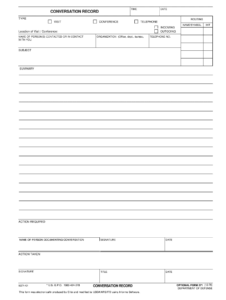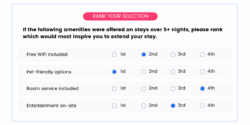Ever had one of those employee conversations where you walk away thinking, “Did I really get my point across?” Or worse, “What exactly did we agree on?” We’ve all been there. Navigating employee relations can feel like traversing a minefield, and sometimes, simply remembering the details of a chat weeks later can be a challenge. That’s where having a solid system for documenting these discussions becomes invaluable. It’s not about creating a paper trail to catch someone out; it’s about clarity, fairness, and building a stronger, more transparent working relationship. Think of it as creating a roadmap of your interactions, allowing everyone to stay on the same path.
In today’s fast-paced work environment, documentation often gets overlooked. We’re so busy putting out fires and meeting deadlines that detailed record-keeping can seem like a luxury. However, neglecting to document employee conversations can lead to misunderstandings, legal complications, and a general breakdown in trust. This is especially true when dealing with performance issues, disciplinary actions, or sensitive topics. Having a clear, concise record of what was discussed, agreed upon, and the next steps involved protects both the employee and the employer.
So, where do you even begin? Creating a reliable and user-friendly employee conversation documentation template is the key. It doesn’t need to be overly complex or time-consuming. A well-designed template will guide you through the process, prompting you to capture the essential details while ensuring you maintain a professional and respectful tone. Let’s dive into why this type of template is so vital and how you can create one that works for your organization.
Why Use an Employee Conversation Documentation Template?
There are several compelling reasons to implement an employee conversation documentation template within your organization. First and foremost, it promotes consistency. By using a standardized template, you ensure that all employee conversations, regardless of the subject matter or the individuals involved, are documented in a similar fashion. This creates a level playing field, reducing the risk of bias and promoting fairness across the board. Everyone is treated the same, and the focus remains on the facts and the agreed-upon actions.
Secondly, a well-structured template provides a clear and organized record of past conversations. This can be incredibly helpful when tracking progress on performance goals, monitoring adherence to company policies, or resolving disputes. Instead of relying on memory or scattered notes, you have a centralized repository of information that can be easily accessed and reviewed. This not only saves time but also ensures that decisions are based on accurate and complete information.
Thirdly, proper documentation can be a lifesaver in the event of a legal challenge. While no one wants to think about the possibility of litigation, having detailed records of employee conversations can provide valuable evidence to support your actions and demonstrate that you acted fairly and reasonably. This is especially important when dealing with issues such as termination, discrimination, or harassment. A comprehensive record can protect your organization from potential liability and help you navigate complex legal situations.
Furthermore, implementing an employee conversation documentation template encourages more thoughtful and constructive conversations. Knowing that the discussion will be documented prompts managers to approach the conversation with more care and preparation. It also encourages employees to be more mindful of their words and actions, as they understand that a record will be kept. This can lead to more productive and respectful interactions, ultimately fostering a more positive work environment.
Finally, having a template promotes continuous improvement. By reviewing documented conversations, you can identify trends and patterns in employee performance, communication styles, and management practices. This data can be used to refine your training programs, improve your communication strategies, and create a more supportive and effective work environment. In essence, an employee conversation documentation template becomes a valuable tool for ongoing development and organizational growth.
Key Elements of an Effective Employee Conversation Documentation Template
So, what makes an employee conversation documentation template truly effective? Several key elements contribute to its usefulness and ensure it serves its intended purpose. First, the template should clearly identify the date, time, and location of the conversation, as well as the names and titles of all participants. This provides essential context and helps to establish the validity of the record.
Second, the template should include a section for summarizing the purpose of the conversation. This should be a brief, concise statement that explains why the meeting was held. For example, it might state that the conversation was to discuss performance concerns, provide feedback on a project, or address a disciplinary issue. Clearly stating the purpose from the outset helps to focus the discussion and ensures that everyone is on the same page.
Third, the template should provide ample space for documenting the key points of the conversation. This should include a detailed summary of what was discussed, including the specific issues raised, the employee’s response, and any agreements reached. It’s important to capture the essence of the conversation in a clear and objective manner, avoiding subjective opinions or personal biases. Use bullet points or numbered lists to organize the information and make it easier to read and understand.
Fourth, the template should include a section for outlining any action items or next steps that were agreed upon. This should clearly specify who is responsible for each action and the deadline for completion. This ensures that everyone is accountable for their commitments and helps to keep the process moving forward. Follow-up is crucial, and documenting action items makes it easier to track progress and ensure that things don’t fall through the cracks. Including a place for signatures is another good way to show agreement.
Finally, the template should include a disclaimer stating that the document is intended to be an accurate record of the conversation and does not constitute a legal agreement. This helps to manage expectations and clarifies the purpose of the document. It’s also a good idea to include a confidentiality statement, reminding participants that the information discussed should be treated with discretion. Creating a good employee conversation documentation template is not too hard if you keep the above in mind.
Think of documenting employee conversations as investing in a healthy and productive workplace. It’s about setting clear expectations, fostering open communication, and creating a culture of accountability. A little upfront effort in creating and utilizing a solid template can save you a lot of time and trouble down the road.
Ultimately, the goal is to build stronger relationships with your employees and create a work environment where everyone feels valued, respected, and supported. Documentation, while seemingly administrative, plays a crucial role in achieving that goal.



